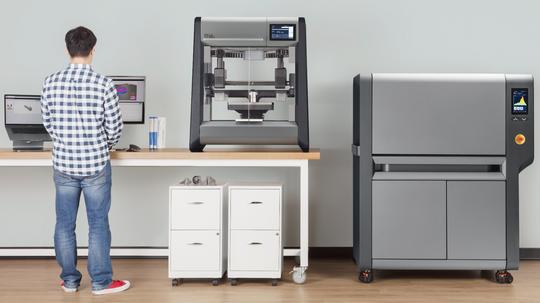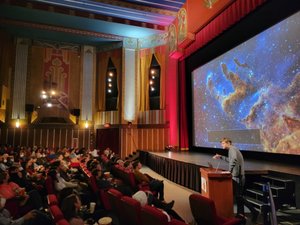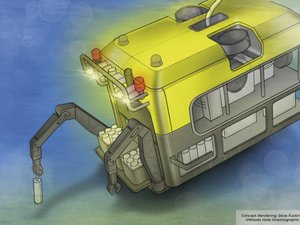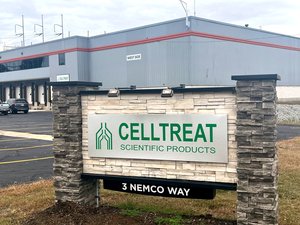
When Ric Fulop talks about his startup Desktop Metal, there's one thing the A123 Systems co-founder and former venture capitalist keeps coming back to: "This is a big deal."
That much has been clear for anyone who has been following the Burlington-based 3D metal printing company since it formed in 2015. In about two years, it has raised nearly $100 million in capital from top-tier investors, including Kleiner Perkins and the venture capital arms of GE, Google and BMW, to just name a few. And its founders are industry veterans, with decades of cumulative knowledge and experience in 3D printing, materials science and other complex technologies.
But aside from its stated mission — to make 3D metal printing more accessible for manufacturing and engineering companies — the company has been mum about how it plans to do that. Until now.
Desktop Metal, one of BostInno's 17 tech companies to watch in 2017, on Tuesday revealed not one but two product lines that aim to bring affordable, cloud-connected 3D metal printers into the office for prototyping and into mass production facilities, where the company plans to compete by making the manufacturing of metal parts faster and more cost-efficient.
"Imagine spending a million dollars and [waiting] every 23 days to get your parts. Not very productive, but they do it in aerospace," Fulop said of current metal printing systems. Desktop Metal's turnaround time for printing parts is only five fours.
"Now we're bringing the cost down so you can do it in many more industries," he added.
The company has already attracted BMW, Lowe's and construction giant Caterpillar, among other Fortune 50 companies, as early customers. Called "strategic partners," these companies have expressed interest in using both product lines and will help with further development.
Desktop Metal's co-founders (counter-clockwise, starting from bottom-left): CEO Ric Fulop, A. John Hart, Jonah Myerberg, Rick Chin, Ely Sachs, Chris Schuh and Yet Ming-Chiang. Photo provided by company.
'Print parts next to where you design them'
Desktop Metal's first product on the market will be the DM Studio System, which the company calls the world's first office-friendly metal 3D printing system. But what does that exactly mean?
"It arrives, rolls through any standard door and all it needs is power, and you're printing parts in an office," Fulop, the company's CEO, said in a presentation with journalists. It also means the system doesn't require a designated operator or the number of safety measures typically needed for metal printers, such as external ventilation because it doesn't use hazardous materials.
The bigger implication, Fulop said, is that "you can print parts next to where you design them."
The system includes a 3D printer and a sintering furnace, which is used to weld the part's layers together, and it will cost $120,000, 10 times less than what a traditional system would cost. When the system starts shipping in September, there will be 30 metal alloys available in the form of print cartridges that start at $300 a piece and can be easily swapped out. The company plans to eventually have over 200 alloys available — which is far more than what laser-based systems support.
'That's why BMW invested in us'
Desktop Metal's other product, the DM Production System, looks to help manufacturers make parts faster and cheaper, with the same level of quality, to the point where it can compete with other mass production processes like casting. And it uses the same kind of metal alloy printer cartridges, allowing for easier transitions from prototype to final product.
At 500 cubic inches per hour, the mass production system can print parts 100 times faster than laser-based printing systems, Fulop said. To give an example in how Desktop Metal can lower the costs of parts production, Fulop said a propeller part that costs $64 made with a laser-based system would only cost $4 a part with his company's system.
"That's why BMW invested in us," he said.
For Caterpillar, the company plans to use Desktop Metal's printers to create a portion of its parts for 21 distribution centers across the world, which will help it cut costs on inventory management.
The mass production system is expected to come out next year for $360,000.
There are a few key ways Desktop Metal's printers differ from laser-based 3D metal printing systems. For one, Desktop Metal separates the printing and sintering processes. The sintering process is enhanced by microwaves, allowing the furnace to safely operate in more environments and heat up objects faster. That use of a microwave-enhanced sintering process, in turn, allows Desktop Metal's printers to use metal injection molding powders, which cost less than what laser-based systems use.
Another major difference is that parts made with Desktop Metal's printers don't require nearly as much post-processing as parts do from laser-based systems. Whereas you would need to use a variety of tools to remove the support structures from a part, Desktop Metal's systems allow you to do it by hand within a matter of seconds.
A multi-billion dollar opportunity
Fulop said the market for metal parts in the world's top 10 developed nations is $1 trillion and yet 3D metal printing only makes up a tiny $1 billion slice of that pie.
"If you look at the reason it's barely scratched the surface is because, in prototyping, the technology is still too industrial and in series production, the technology is not fast enough and not low cost enough," he said.
With Desktop Metal, Fulop is clearly trying to change that.








